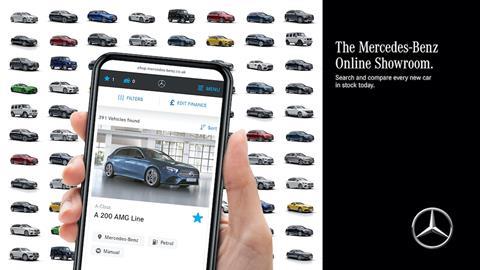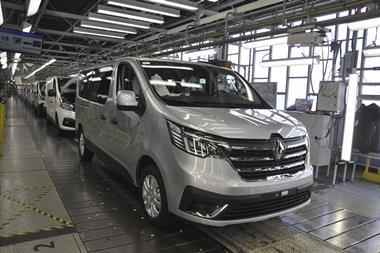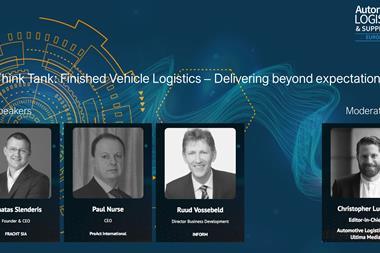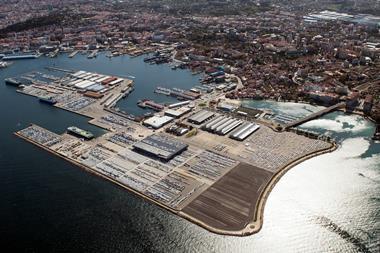The impact of the Covid-19 pandemic has accelerated a latent online sales trend, with more than 50% of vehicles across Europe currently sold across some form of online channel, according to new research. This has solidified automakers’ roll out plans for new sales structures across the continent and beyond.

Purchasing a new car increasingly involves an amalgamation of online digital tools and something like the offline physical experience of a traditional dealership. This omnichannel approach is defining the new role dealers are to play when selling a car. In Europe and many other markets, the Covid crisis has quickly led to an explosion of online sales processes and alternative delivery patterns for customers.
It’s a change that we expect to be permanent and to have implications for the supply chain and vehicle logistics.
Through 2020 the top European car markets managed to maintain their market share despite sales falling and dealerships being closed for the most part, or when (intermittently) open, subject to stringent new protocols to keep contamination at bay. The sales that took place were markedly different in the way the transaction was carried out.
ECG Business Intelligence, a collaboration together with Automotive from Ultima Media, analysed the status of dealerships and found that those predominately closed or operating under significant restrictions in 2020 accounted for around 59% of the total volume of new passenger cars that were sold in Europe in 2020. Automakers and dealers therefore adapted quickly to new market conditions, moving sales online. While car sales in general declined by 29.6% in 2020, ECG Business Intelligence estimates that the number of sales made via online platforms rose by a staggering 645%. That figure is based on final sales levels reached during closures and restrictions for dealerships last year.
Overall, the use of an online sales channel was involved in 53% of new passenger car purchases in Europe in 2020 (ECG members can access the full report here). That could include relatively simple digital implementation, such as a ‘click-and-collect’ arrangement online with handover at dealers, right through to arranging for alternative or home delivery. While the vast majority of these online delivery arrangements were organised through dealers, in some cases OEMs have arranged direct delivery – and that is a trend that may accelerate further.

Necessity is the mother of invention
The pandemic has made physical visits to showrooms a very different experience, often with the need to pre-book appointments and for limited periods only. But well before Covid, OEMs were increasingly looking to turn dealerships into ‘experience centres’. This concept has of course been long pioneered by Tesla, and had also been touted by Volkswagen pre-Covid for the launch of the ID.3 and ID.4 electric vehicles in Europe.
The Alliance of Europe Car Dealers and Repairers (AECDR), states: “OEMs invariably distribute their branded vehicles to consumers through selective distribution networks, although a number of OEMs are exploring agency arrangements and direct/online sales alongside their independent dealers. This trend is only likely to increase in the wake of the Covid-19 pandemic.”
Meanwhile, dealers in Europe have had to introduce a myriad of protocols to keep their operations running amid the pandemic even as government restrictions required in-person sales to close. Even when open, dealers have not wanted the general public to flock into their stores when Covid-19 was rife. Dealers have requested new car buyers to negotiate almost all aspects of the sale over the phone, on social media, via email, WhatsApp or via an online sales platform. Payments are made using a secure link online. For those uneasy with online sales, the options of popping over to the dealership and paying by card include various precautions, including keeping to a two-metre distance, disinfecting surfaces and using and plastic covers on contact points, such as seats and steering wheels.

Agency sales model
These measures have in fact accelerated plans to rapidly introduce the agency sales model in Europe. This is a direct sales model and simplifies the process making it, in essence, a two-tiered system. VW said in a statement: “The agency model lays the contractual foundation for integrating online business and showroom-based business. From sales launch, customers can order vehicles from the ID family direct from Volkswagen. At the same time, they select their preferred dealer for personalised customer care and local services.”
The OEM sets a fixed price online and deals directly with the buyer, thereby eliminating any dealer haggling. In return the dealer gains an agent fee and becomes the point of contact for the new car buyer for aftersales services, now referred to as the long-term care plan. Referring to the restructured sales model, Jürgen Stackmann, board member for sales of the Volkswagen brand stated: “This is the right step at the right time.”
Meanwhile, Dr Matti Pörhö, president of the European Dealer Council (EDC), which represents the interests of VW dealer councils in Europe, said: “We believe in the new business model as it will strengthen dealers’ entrepreneurial responsibility. In the areas of digitalisation and e-mobility, the major tasks for the future, dealers will play a key role. To shoulder these challenges, dealers need a firm foundation of profitability.”
In 2021, Kia Motors, already an early adopter of the agency sales method in the Balkan region, started a pilot in the Netherlands. Mercedes has been trialling the agency sales model in Sweden since April 2019 and is to roll it out in Austria this year. The automaker aims to significantly ramp up its online sales platforms as it aims to sell 25% of global volumes online by 2025. Volvo Cars has also announced ambitious plans to sell 50% of all its vehicles online by 2025 and 100% by 2030.

Automakers such as Volvo Cars and Lynk & Co are also touting the subscription model, where the new car buyer pays a fixed monthly fee to the OEM for the use of the car, while the dealer, acting as an agent, gets a fee to manage the servicing of the vehicle.
Online sales and their impact on vehicle logistics will be discussed at the Automotive Logistics and Supply Chain Europe Live virtual event on April 20-21. Check out the agenda here.
Online sales to dominate
While automakers are looking to significantly strengthen global online sales, in Europe the pandemic has accelerated this shift.
In fact, ECG Business Intelligence estimates 53.8% of new passenger car buyers in 2020 are estimated to have used some method of online sales to complete their transactions, including ‘click and collect’. This was a rapid increase from an estimated 5-6% of the market in 2019. One of the reasons behind this surge has been the introduction of online sales platforms across Europe, led both by OEMs and dealers.
When governments initially introduced lockdowns in the second quarter of 2020, the shockwaves hit the industry hard and latent plans to introduce online channels were accelerated. Dealers and automakers across Europe had by Q3 already introduced strong messages that they were open online, thereby encouraging new car buyers to continue their plans to purchase.
This ease of purchasing online resulted in an estimated 20% of new car buyers in Europe choosing home delivery options for their purchases. Home delivery is a broad term, and dealers often make informal arrangements with new car buyers to deliver the vehicle to them with private drivers. The dealership uses the service of a new car delivery driver, following full Covid-19 protocols, such as wearing gloves and masks, to drive the new car from the dealer to the buyer’s location. The cost is usually covered by the dealer.
However, vehicle logistics providers have also risen to the situation and looked to introduce home delivery services. In May 2020 French logistics supplier Gefco began delivering new Ford vehicles direct to customers under its Moveecar service, for example. Another method used under home delivery is if the customer agrees to pay for a car hauler for the bespoke delivery of the new car.
In future, direct delivery arranged by OEMs could also involve a more coordinated logistics service using carriers to multiple locations.

Meanwhile, an estimated 33.8% chose to click and collect. A spokesperson for ABP Ports told Automotive Logistics that the increased use of online digital tools helped keep volumes moving at ports. “One of the major impacts of Covid-19 has been the imposition of social distancing measures, which have transformed consumer behaviour and accelerated the transition towards digital tools such as click and collect,” the company said.
However, even in a year when so many physical stores were closed, 46% of sales still used purely offline sales channels, according to ECB Business Intelligence estimates. As dealers reopen, there will be a dip in online sales transactions as those buyers that delayed purchases or were nervous of using online channels push up the volume of offline sales. However, with the growth in ecommerce across industries and the ease of the transactions using secure systems, those who have purchased using an online sales method will likely do so again.
Temporary measures become permanent
Buying a car is a complex process. For most people it is the second-highest value purchase following after a house. With the high stakes involved, most new car buyers feel a need to experience the purchase before completing the transaction, and they need to be assured that the price they are being quoted is the best price there is.
With the sheer complexity of the process, the omnichannel approach offers opportunity to streamline the buying processes. This includes an online sales channel with a clear fixed price set by the OEM, while the visit to the dealership offers the new car experience that buyers want. It is therefore an agency sales model but includes that essential ‘touch and feel’ element achieved by a test drive or visit to the dealership.
ECG Business Intelligence has highlighted five aspects of the new sales system that help OEMs and dealers meet the needs of the new car buyer which include:
- Secure transactions
- Test drives
- Fixed prices
- Simplified options (which in essence are pre-selected trim specifications such that lead times are minimized)
- Legal rights for online buyers.
To offer this as a solution to counter lockdowns and stringent safety protocols, OEMs and dealers in Europe have invested significantly in new systems and streamlined services such that new car sales can continue despite the pandemic. Covid-19 has accelerated digital sales, and the adoption of digital tools in the sale and delivery of vehicles.
In 2020, carmakers and dealers pushed sales using the phrase ‘open online’, thereby initiating a permanent change to the way new car sales are carried out in Europe. The pandemic has made permanent the temporary measures that were brought in to keep sales moving through the lockdowns.
A full analysis of the temporary measures bringing about permanent change can be found at https://ecgassociation.eu

























![Global[1]](https://d3n5uof8vony13.cloudfront.net/Pictures/web/a/d/s/global1_726550.svgz)














No comments yet